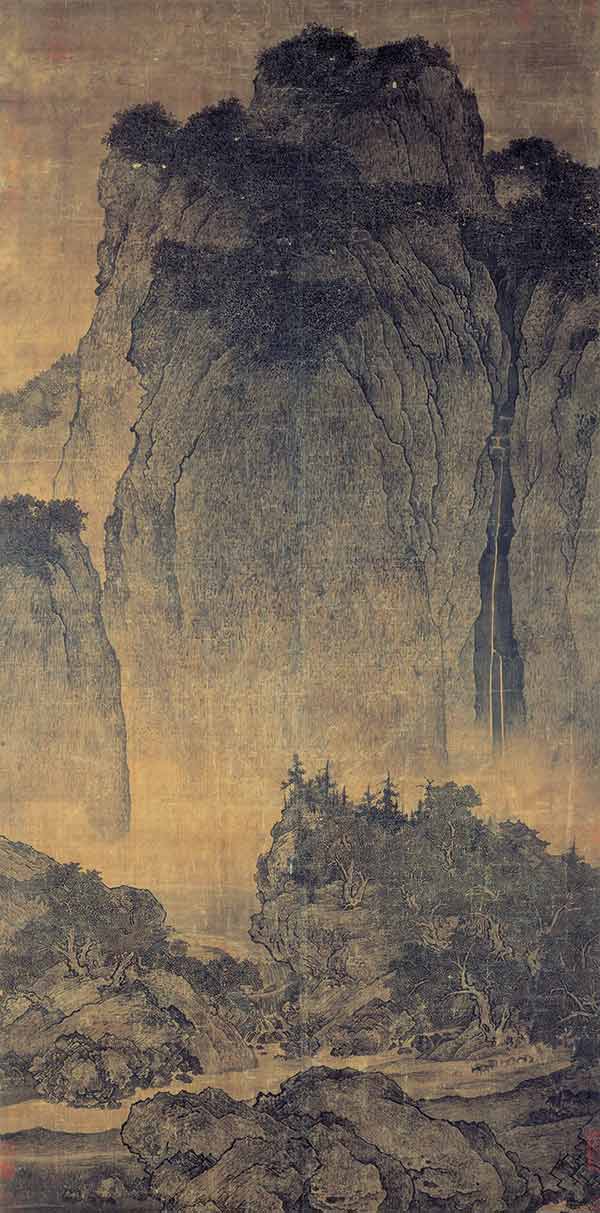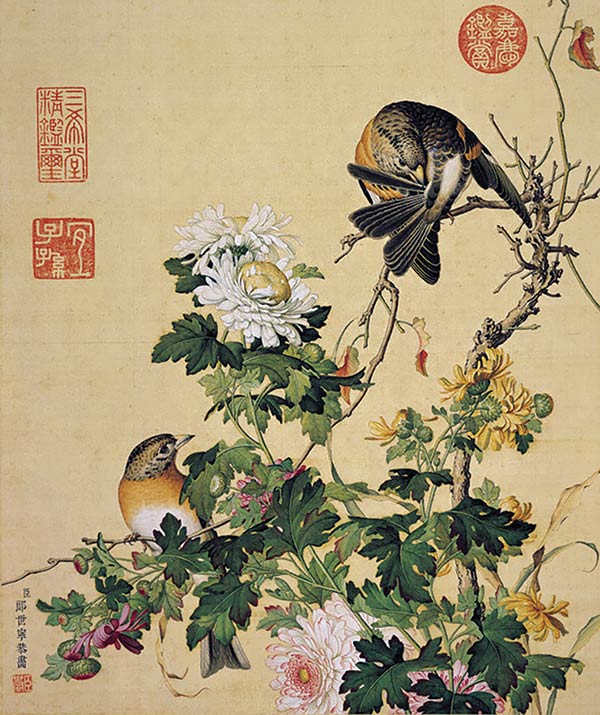Subtotal: $
Checkout
A distorted gold cat wags its paw on the other side of a bubbling aquarium. The smells of cashew chicken and egg drop soup mingle with the Chinese-instrument covers of pop songs coming from the ceiling. You know the scene. In the back of the room, behind the paper lanterns, hangs a landscape painting in shades of emerald and topaz. Some mountains, a river, maybe a few cranes flying. Nice.
But the great works of Chinese nature painting are not just nice; they are not even just paintings. They are often poetry, philosophy, and prayer all at once. In this tradition, painting is the fruit of contemplation, and, when this is true, it is also a kind of prayer. In creating, the artist identifies the spiritual meaning of things and seeks to help the viewer to see them too. This art can help the viewer to pray with nature in a new way, to love it, to see in it something of the divine.
In the late northern and southern Dynasties, or around the turn of the sixth century, in Western terms, the writer Xie He composed his famous “Six Principles” of painting. The first of them calls for qiyun shengdong, “spirit-resonance showing life-motion,” usually understood to mean that a painter needs to capture the essential character of his or her subject in order to make it come alive in the artwork. Without spirit-resonance, a painting feels static, flat, and opaque. The goal of Chinese landscape painting is not mere accuracy of illustration, but capturing the spirit of a place, which requires a process of contemplation where the painter comes to understand the poetic meaning of the subject.
Jacques Maritain, the Catholic philosopher, thought this Chinese notion of spiritual resonance pointed to something fundamental about art in general. Poetry, in his view, is the spring of all art, which is about seeing analogies. If we think of a big old oak as proud and noble, we are seeing an analogy between the tree and the human spirit. An artist can pick out those connections well, and make something (a song, a poem, a painting) that communicates them. An artist can show that mountains have something in common with honor, that a wren shares something with a joyful heart, that a breeze at night is not unlike a heartbreak.
Guo Xi, a painter and writer who lived some four centuries after Xie He, indicated that the painter’s ability to see the spiritual meaning of things depended on his or her own spiritual character: “A virtuous man takes delight in landscapes so that in a rustic retreat he may nourish his nature, amid the carefree play of streams and rocks, he may take delight.” To see in nature the qualities of excellence and virtue, the artist must be attuned to receive them.
In the time of Guo Xi, perhaps no one better embodied painting as a spiritual practice than the mountain man Fan Kuan. With his rough clothes, grey-flecked beard, tanned and weather-beaten skin, and open face etched by deep thought, he was known as generous and easygoing, a lover of mountains, wine, and, above all, the Way – the path in life and harmony with nature known as the Tao.
As a young man, he left the wealth and hypocrisy of the city for a contemplative life in the Qinling mountains. As excellent as he was at copying the old masters, he came to feel that time spent with nature itself was the only way to paint it authentically. He also seems to have wanted to escape the pretensions of the artistic circles in the city in order to live a more authentic life. In his hermitage, he watched the course of the seasons, was buffeted by the extremes of mountain snows and rainstorms, and came to know the cliffs and valleys in each of their moods. He lived in and with this landscape, fished its streams, hunted in its valleys, and meditated on its prominences.
His life of meditation in the mountains was an effort to become one with things, and his Travelers by Mountains and Streams displays the result of years of discerning the spiritual qualities in the highlands of Shaanxi.
Towering peaks rise in the mist behind the middle ground, where tiny travelers magnify the majesty of the heights. A third layer of close, craggy stones separates us, the viewers, from the pathway of the travelers and makes us feel as if we were at the edges of the scene; we seem to peer over the stones at the vastness of mountain walls above us. As art historian Richard Barnhart has written, some commentators of Fan Kuan’s own age thought that the closeness and strength of the scene, which crowds and presses upon the viewer, is meant to be an embodiment of wu, or martial virtue. Contemporary scholars like Wen Fong have seen in the tripartite composition a Confucian message that all things are harmoniously ordered: the foreground might be seen as the small realm of man, the middle ground the space of nature, and the mountains shoot up to represent the divine.
These mountains are not painted as they would look in a photograph; each choice of brushstroke, of shade, of placement is made for a reason – to depict the scene as filled with meaning and memory. The Tao is not reducible to human language, the classic Taoist texts hold. Art, however, speaks in another way. Analysis of the painting is not as good as merely spending time with it.

Fan Kuan, Travelers by Mountains and Streams, circa AD 1000 (Public domain)
This is part of the reason why classical Chinese painters so often abandon normal limitations of perspective and unity of composition; they are emphasizing a scene not as it presents itself to the eye, but as it inhabits the soul. In a photograph, our vision is limited by the lens. In a painting like Fan Kuan’s, we see the mountain, not as it appears from one vantage point at one time, but as it appears to a man who has walked among its nooks and crannies, loved it, and come to associate it with the various events of his life. Guo Xi called this freedom of perspective the “angle of totality.” For the artist who lived in these mountains, each part of the scene has become a friend and reveals a personality.
Fan Kuan sees in the Qinling peaks fortitude, long-suffering patience, cheerfulness, purity, hospitality, and austere beauty. He reveals fortitude in the unshakable mountains; patience in the bent, sturdy trees; cheerfulness in the travelers; purity in the thin waterfall that splits the cliff face; and hospitality in the tiny temple hidden in the forest. This is what Maritain called the “interpenetration of man and nature.”
When we look at this painting, we enter a kind of conversation with its painter, an encounter between our beliefs and associations. Fan Kuan invites us to contemplate the spiritual significance of the beautiful country he knew. His heart resonates with the landscape and, through his work, our hearts as well.
Maritain held that this spiritual resonance in art does not extend laterally alone, between one thing on earth and another, but vertically, to the divine. In a similar spirit, perhaps, the apostle Paul writes that the invisible attributes of God, even his eternal power, have been clearly seen in things that are made (Rom. 1:20); Chinese landscape painting has a wonderful way of revealing this.
Centuries after Fan Kuan passed beyond the Qinling mountains, another painter came to China from across the sea. Trained in the studios of Italy, Giuseppe Castiglione (1688–1766) would become the court painter of three Chinese rulers and the dear friend of the Qianlong Emperor, who praised his virtue and goodness as much as his artistry. He is remembered in China as master painter Lang Shining.
Lang Shining was trained by the Baroque painter Andrea Pozzo, still famous for the masterful illusionist ceiling of the Church of Saint Ignatius in Rome. Other European artists had tried and failed to bring the vision of the West to China, but only Lang Shining had both the talent and understanding to harmonize the spirit of the Celestial Kingdom with that of Christian Europe.
Lang Shining was a Jesuit brother, and the teaching of Saint Ignatius to “go and seek God in all things” can be observed in his artistic as well as his pastoral work. Arriving in China in the time of the Kangxi Emperor, he encountered a ruler who felt a real affinity between his own Confucianism and the teaching of the Jesuits, and wanted to encourage a dialogue between the two traditions. Likewise, the Jesuits found much to admire in Confucianism.footnote The notion of finding God in all things is a key touchpoint with the spiritual vision of the Chinese landscape artists, so intent upon meditating on divinity in nature. The poet Zhang Ruitu (1570–1641), from Fujian, wrote these lines about the similarities between Chinese thought and the teachings of the Jesuit Guilio Aleni (1582–1649), whom he had come to know:
Like rivers to the sea, one flows into the other.
Mencius speaks of “serving Heaven”;
Sage Confucius speaks of “overcoming self.”
Who would think this man comes from a different country?
The words he sets forth are of this very stripe!
Geography? – What does it matter?
What counts is that the frame of mind’s the same.
It was this felt commonality that made Lang Shining’s achievement possible. His work resonates with the view Maritain would express centuries later: Christian art is not limited to church-related things but extends to anything that is beautiful and spiritually radiant. As the apostle Paul enjoined in Philippians 4:8: “Whatever is true, whatever is honorable, whatever is just, whatever is pure, whatever is pleasing, whatever is commendable, if there is any excellence and if there is anything worthy of praise, think about these things.”
Lang Shining’s work is a guide for the Christian West into the world of Chinese painting, and so into the world of Chinese contemplation. The dialogue within his paintings between Chinese composition, framing, and vision and Italian perspective, depth, and shade echoes the spiritual dialogue that occurred when the Jesuits met with the Confucians in the court of the Kangxi Emperor. Lang Shining’s paintings contain what both traditions share, and each has its own unique ways of revealing – that contemplation of nature which attempts to see and love things as they are, and to understand their spiritual meaning.

Lang Shining, leaf from Flowers and Birds, seventeenth century (Public domain)
The philosopher Josef Pieper said that contemplation consists of looking at something, anything, for its own sake, and saying “yes” to it. “Yes,” you are good; you are lovely; it is good that you are here. Contemplative affirmation is ultimately grounded in a deeper affirmation, a “yes” to the world and to its source. It is an echo of the primeval utterance of God on his creation: “Indeed, it was very good” (Gen. 1:31).
“There is no nonreligious contemplation,” Pieper wrote. “Awareness of the divine element can be kindled by virtually anything encountered.” Prayer – praise – is incipient in the affirmation.
The minimalism of these paintings, the use of emptiness, the perspective of totality, the emotion of the brushwork – all are meant to reveal the poetry in things, the transcendent in nature. They help us to see earth as permeated by heaven. In this, the tenth-century painter Jing Hao rightly called them “divine.”
Rainer Maria Rilke observed that when we look at the beautiful, it looks back into us. In the light of beauty, we understand that we must change our lives for the better. In drawing us into a contemplation that reaches out to God, the beauty of Chinese landscape paintings can help us overcome ourselves and to serve heaven.
Footnotes
- A long debate on Confucian rites arose between the Jesuits, who encouraged Chinese Christians to retain the Confucian traditions that were compatible with their new faith, and the Franciscans and Dominicans, who called those traditions pagan and idolatrous. Roman authorities wavered on the question, until, finally, Clement IX was convinced to ban the Chinese rites. In response to this drama and the ban (and affronted by the manner in which it was delivered) the Kangxi Emperor reversed his sympathetic policy and severely limited missionary work. In time, the Jesuit view would win out, and Pope Pius XII would issue Plane Compertum Est, rescinding the ban on Catholic participation in the Chinese traditions.
Already a subscriber? Sign in
Try 3 months of unlimited access. Start your FREE TRIAL today. Cancel anytime.





















Christina
Looking at Travelers by Mountains and Streams, I had an epiphany: This is an icon. The beauty of God shines forth here just as surely as it does from a masterful icon—for instance, The Holy Trinity by Rublev.
Lawrence Brazier
Indeed more than just art. Simply gorgeous. Probably as close to mystical depiction as we are ever likely to otherwise find.
Ben S.
As the son of immigrant Chinese parents to America, I have been rediscovering my Asian roots, and reading this and seeing the sample paintings was a real delight. I have often felt that Classical Chinese paintings are often regal and delicate, albeit elusive. Much of my own American (and Protestant) sensibility relishes in the obvious, the practical, the bold. And yet, it is the subtle, the essential, and delicate that we find when we pause and look. Thank you!